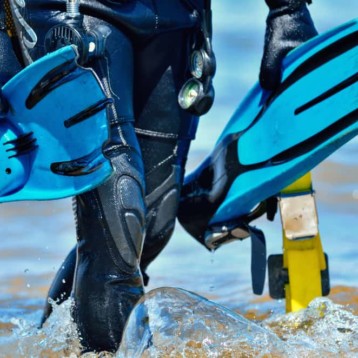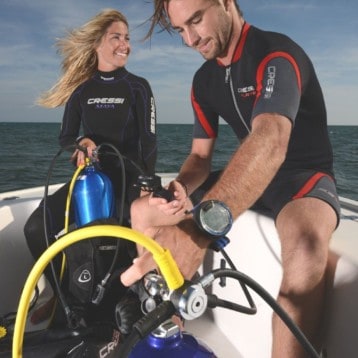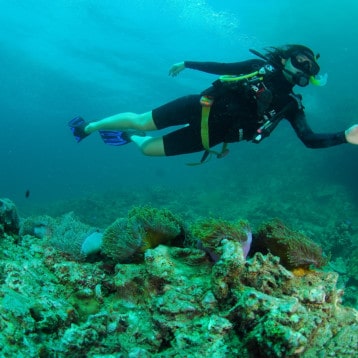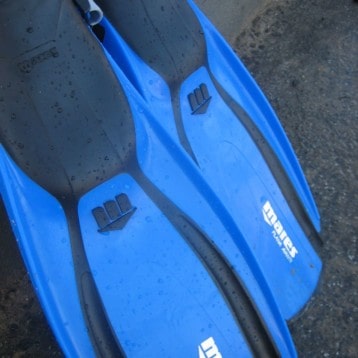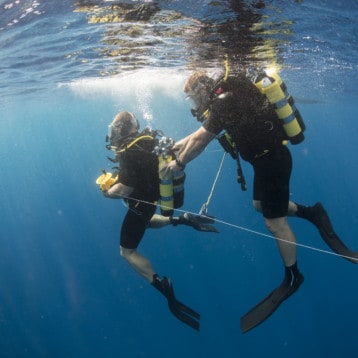The best dive knife is one that will work in that instant you need it. Like many other knives, it isn’t a weapon. It’s just a tool to be used that will help to keep you save when there’s a dangerous situation in the water. Most divers never use their knife for anything other than getting untangled from some discarded fishing line or cutting through a rope. It’s usually the only tool you have with you, so it needs to be as versatile as possible.
Table of Contents
Here Is the Best Chart for Dive Knives
There is a ridiculous amount of different shapes and sizes to the modern dive knife. How can you choose the very best with all of that variation? This chart helps to make the decision more manageable, showing you the information about the best dive knives so you don’t just have to choose one that looks cool.
Here Are the Salty Dog’s Favorite Dive Knives
Promate Scuba Dive Snorkel Titanium Knife


This is a virtually maintenance-free dive knife that has a rubber handle that’s been ergonomically molded for good leverage. The titanium blade is strong, but does need a little help in the sharpening department over time. There’s a titanium hammer on the handle bottom and is surprisingly lightweight. With the included strap and sheath, you’ll be able to bring the knife along on virtually any dive and not have any difficulty. Select a sharp tip or a blunt tip to have all of your preferences met and you’ll have made a great investment.
Aqua Lung Squeeze Lock Titanium Tanto Tip Dive Knife


Why is this one of the best dive knives available right now? Take a look at the locking mechanism and you’ll see for yourself. You’ll have to lose the entire sheath to lose this knife on a dive thanks to the patented locking system. All you’ve got to do is squeeze the handle, however, and you’ll be able to have the knife ready for use. It features a tanto tip, which some divers may not be so keen on having, but the 3 inch blade is super strong and easy to reach. It’s light, useful, and stays rust-free. That’s what makes it a worthwhile investment.
U.S. Divers Titanium 5-Inch Diving Knife

This 5-inch titanium knife looks fierce and provides a good, consistent result. There’s a serrated top edge that works to cut through the toughest of materials, while a line cutter for safety is also included. A finger guard on the tang helps to secure the grip while keep the fingers from getting sliced and cleaning the knife is a simple process thanks to some of its assembly features. The sheath offers a quick-release design and the rubber leg straps are appropriately comfortable. The cap is made from stainless steel that is equally resistant to corrosion and this all adds up to one of the best knives around.
United Cutlery UC0247B Sting Ray Dive Knife

If you’re on a tight budget, the Stingray knife offers an extremely lightweight, durable design that will stand up to any other dive knife. The 4-inch blade is made from AUS6 stainless steel and the sheath has a built-in impact resistance that will protect the knife. The holes in the tang do more than just provide a firm, lightweight grip. They also help to keep water funneled away from your grip so that you’re less likely to lose the knife. As long as you clean and season the blade after a dive, this knife will last a long, long time.
McNett Saturna Blunt Tip Outdoor and Dive Knife

A blunt tip knife is an essential tool for a diver as they help to reduce the risks of a tip point puncture without compromising on the sharpness of the blade. The sheath is made from Kydex and features a quick-release design and plenty of attachment options so you can be comfortable with it out on the water. It disassembles for easy cleaning and has a price that every budget can afford. If you need the best dive knife, then this one must be considered.
What Are the Basics of a Dive Knife?
You’ve got two basic options with the modern dive knife: folded or fixed. Folding blades are smaller and more compact and fit into pockets. Because they fold up, the risks are reduced that an accidental puncture is going to happen. If you’re wearing gloves, however, a folding knife can be a little cumbersome.
Fixed blades are the usual diving knives that you’ll find today. The best thing to consider with this type of blade is the sheath that helps to protect it. If the fit isn’t smooth and easy, then there’s a good chance that you’ll drop the knife during a dive. A tight fit can also lead to an accidental slicing or puncture that you don’t want.
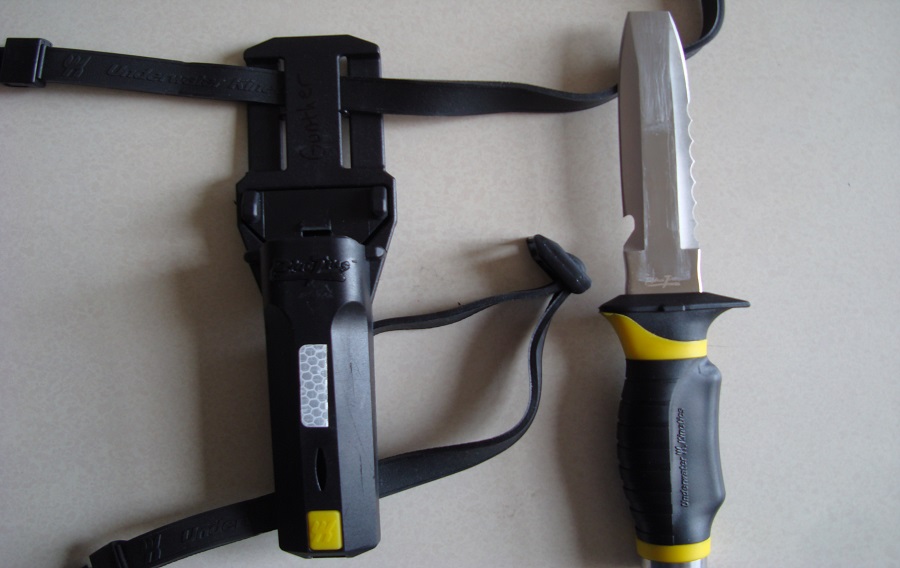
What Are the Advantages of the Best Diving Knife?
The best dive knife is typically made from titanium. This is because they are incredibly strong and are resistant to corrosion. Titanium knives can sometimes be problematic, however, because they can be difficult to sharpen. Because they are maintenance-free, however, they could be a viable solution for your diving needs.
Steel knives are a good second option. They hold an edge well, are easy to sharpen, but require more overall maintenance to keep them from rusting. Steel knives come in two different types of alloys. The 300 alloys are more like titanium knives – easier to care for, but more difficult to sharpen. 400 alloys stay sharper and need to be protected from rust. Serrated or straight edge blades are typically user preference, but do get a line-cutting notch and look for metal handles first to get the best possible experience.
Most dive knives are going to be found on a site like Amazon for around $50 and be a great knife. Some are cheaper and require more maintenance, while others are more expensive and require more effort to sharpen.
Features of Best Dive Knives
Before purchasing any item, it is important to know its key features to evaluate what your requirements should be. The same is the case while selecting a dive knife. There are several features you should look out for when choosing the perfect dive knife for your use. These include:
Sharp Tips
Sharp tips in a knife are popular amongst the spearfishing community. Such tips are very useful for puncturing, cutting, drilling holes, or impaling and hence, are sometimes used by recreational divers as well.
However, sharp tips increase the risk of injuries and can damage your equipment if the knife accidentally moves out of its sheath. The selection of the type of tip comes down to what you want to use your dive knife for.
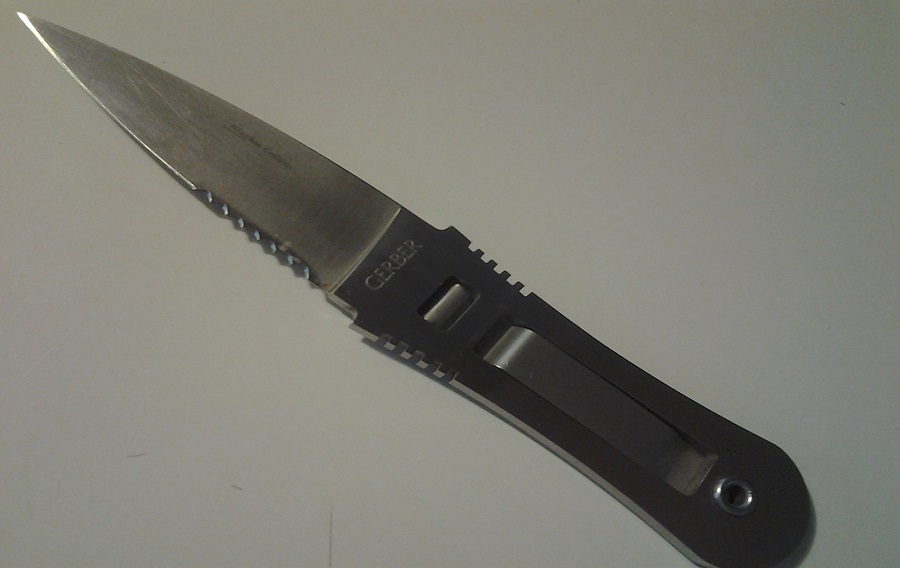
Blunt Tips
Blunt tips tend to be flexible in use. They are useful in digging, prying, and hacking and hence, are preferred mostly for scuba diving. Additionally, blunt tips are required to work in place of flathead screwdrivers or as levers to open something. Blunt tips make the knife a safer commodity as compared to sharp tips. Again, in the end, it depends on your preference and what you require from a dive knife.
Line Cutting Notches
Fishline or rope cutters can be purchased separately. However, they are sometimes integrated with the dive knife. The sack-like shape at the top of the blade can be identified as the line-cutting notch. It can be used to cut fish lines as well as a rope if you were to get entangled.
Metal Handles
Metal handles are very useful as you can bang them against a boat or your friend’s tank to grab someone’s attention. However, the risk with metal handles is that they make the knife less slip-proof and more uncomfortable to hold.
Black Blades
Black blades make for an appealing look, and the knife invisible against marine life. The downside is that if you were to drop your knife, the black blade would make itself invisible to you too, and it would be harder to retrieve.
Ergonomic Handle
You should always hold the dive knife to check if it is comfortable to hold and has quick grip access before making your purchase. Dive knives are tested for several factors that make them easier to use. These factors include:
- The locking mechanism should be easy and instinctual for you. It should confirm with a click sound so that you can know for sure that the knife is secure without actually checking it and that it remains safe.
- The sheath provides further security to the dive knife. It is sometimes made with a material with a flap covered with Velcro that saves it from falling out.
- It should be easy to remove from and place in the sheath regardless of whether you wear gloves or not.
- The addition of a safety string will prevent you from losing your knife forever to the depths of the ocean if it were to fall from your hand.
- Your comfort with regards to the grip on the knife when it is used for cutting.
Every knife is different, and you need to find one whose feel, fit, and finish proves to be the best for you.
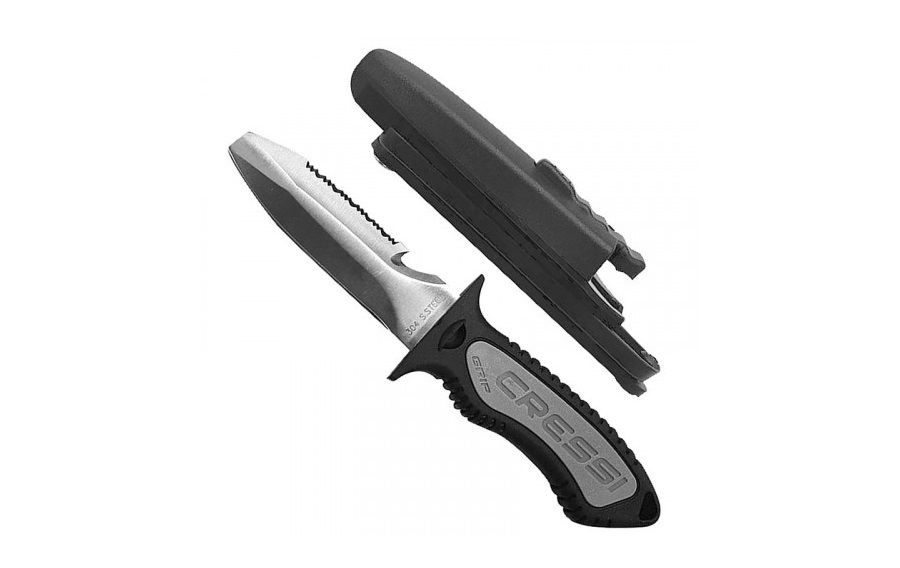
Dive Knife Attachment
Dive knives have different attachment mechanisms according to their sizes. Large knives are better suited to be attached to the leg, while smaller, more compact knives are more convenient to attach to the equipment, such as the BCD or air hoses. Some knives are kept in the pocket.
All these attachments are effective in different ways. The most important factor that remains is the location. Your knife should be attached to a place where you can easily retrieve it without any hassle. To make things clearer, here are more details about different attachments and their effectiveness.
BCD or Hose Mounted Knives
The buoyancy compensator (BC) or buoyancy control device (BCD) sometimes has holes built-in to attach the knife. If the knife is not very big, it can also be attached to the inflator or corrugated hose through cable ties. Alternatively, some knives have a strap or a string that can be tied to one of the rings or any other element of the BCD so that the knife can be kept in one of the pockets of the BCD.
The advantage of having your knife attached to the gear is that you won’t forget to bring it along with you. However, you will need to be careful to detach your knife and clean it separately from your equipment to make sure it stays sharp and rust-free.
Leg Mounted Dive Knives
Two rubber bands are attached to the leg to hold the sheath that holds the knife. This way, the knife becomes easy to access for you, but there is always a risk of the knife getting stuck to rocks or other items underwater. Divers opt for such knives because of their large size.
Foldable Dive Knives
Foldable dive knives, as the name suggests, are knives that can be folded and be kept in your BCD’s pocket without a sheath. These are lightweight and smaller. They are also relatively safe because they cannot become unsheathed and hurt you or someone else in the process. However, these knives are difficult to unfold if you are wearing gloves and also require the use of both hands to undo their locking mechanism.
Handle Construction
The construction of the handle should be slip-proof. Usually, a wishbone is used at the end of the blade to prevent it from slipping from the hands of the diver.
The Material of the Handle
Several types of materials are used for the handle, such as stainless steel, titanium, or plastic. When it comes to the handle of the dive knife, the most important thing is that its size and shape should make it easy to use, even if the diver has gloves on.
Blade Material
Several types of materials are used for the blade of the dive knife. Some of them are steel, stainless steel, titanium, brass, and ceramic, etc. Each of these has different advantages and disadvantages to them underwater:
Steel
A dive knife with a steel blade will cost you less than other dive knives, but the cost might not be worth the short lifespan. Steel is comparatively cheaper but also tends to rust quickly, making it a less durable option. If you are looking for a knife to use long-term, a steel blade is not the best option.
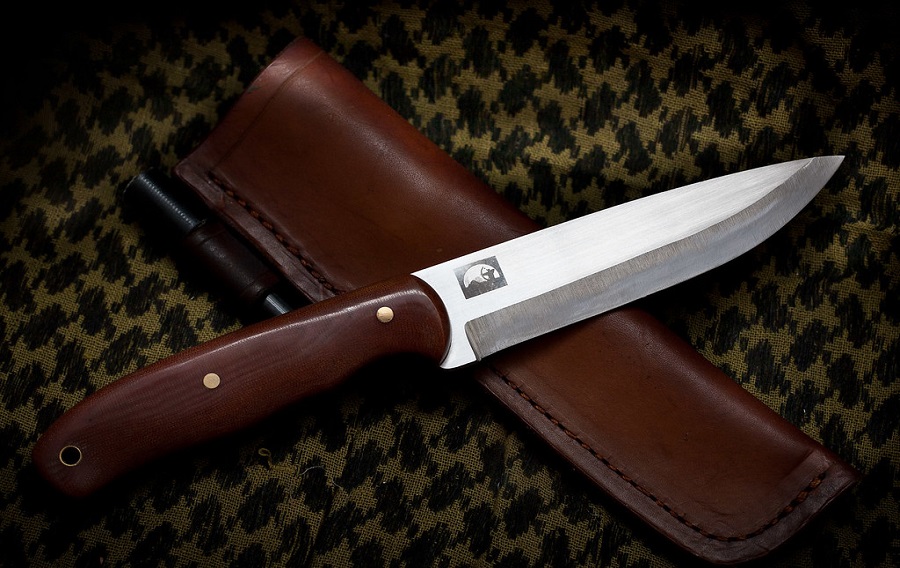
Stainless Steel
Steel mixed with different metals turns it into stainless steel. This mixing makes stainless steel less prone to corrosion, and hence, stainless steel knives have a longer lifespan. However, the tradeoff is that stainless steel is softer than steel. This means it will require more sharpening than usual, but it will also be easy to sharpen.
Titanium
Titanium is the best material to use for a dive knife. It is strong and unbreakable, which makes it harder to sharpen than stainless steel, but it requires less maintenance as well and will last longer, owing to its flexibility. It is lighter than steel and highly resistant to corrosion. Plus, it is rust-proof in saltwater. Consequently, it is more expensive than other materials, but if you want your dive knife to be a one-time investment for a significant amount of time, then a titanium blade dive knife is the best option.
Ceramic
Dive knives with ceramic tend to be more expensive. At the same time, ceramic is brittle and is easily breakable, so it is not a good choice.
Care and Cleaning
Dive knives can get you out of different predicaments. You can free yourself from an entanglement underwater, or it can help you get a hold of your friends’ attention through the metal handle. However, your knife requires regular maintenance to be able to keep doing what it is made for and not break or rust.
These are important things to check before you go for your dive. These include:
- Assess the knife for any corrosion on the blade as well as the lock.
- If there is slight corrosion, you can clean it with a towel or toothbrush.
- Make sure to check the lock or sheath lock to see if it is working properly.
- If the lock or opening mechanism seems to be stuck, make sure to lubricate it with silicone.
These are some tips you can follow after your dive to ensure that your knife lasts for the maximum amount of time possible:
- Once you come out of the saltwater, make sure to rinse your dive knife immediately with fresh water and let it dry outside without the sheath.
- The buttons on the lock of the dive knife should be pressed to make sure all the saltwater, debris, and dirt are removed from it.
- Coating your dive knife with silicone grease protects it from rusting in saltwater. However, do not use petroleum-based lubricants on it.
- If there is visible rusting on your dive knife, you can rub it with fine sandpaper and then coat it with silicone grease again.
Summary
The best dive knife doesn’t have to cost a lot. For an affordable price, you can get an awesome tool that can be used when you need a little help in the water. Use these dive knife reviews and the information here to find the best tool possible and you’ll be safer on your next water adventure.


